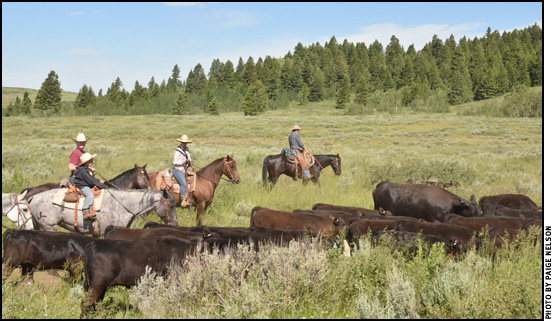MANAGEMENT...

Grazing Can Reduce Wildfires
If livestock can be grazed in balance with their feed source, wildfires are kept to a minimum and are not as devastating.
Many people today think fire is “natural,” but devastating fires are not. Grazing is healthier for the landscape.
“Fire can oxidize a lot of material and waste it, whereas grazing recycles it better,” says Fred Provenza, professor emeritus in the Department of Wildland Resources at Utah State University.
Native Americans burned the prairies, and lightning set some fires, but those areas were also being grazed — with large herds of bison, elk and antelope. There wasn’t a lot of fuel load to carry a major fire. A fire episode was usually a flash-through that didn’t damage so much. Read more.
Don’t let Fire Ants Ruin Your Summer
Ants are most active above ground during spring.
Dealing with fire ants is no picnic, but getting rid of them can be as easy as step 1, step 2, according to Texas A&M AgriLife Extension Service experts.
Allen Knutson, AgriLife Extension entomologist, Dallas, Texas, said spring is a good time to control fire ants, as this is when they search for food and build mounds, which makes them easier to locate.
Broadcast baits are the core of AgriLife Extension’s recommended treatment. The method becomes effective as temperatures begin to rise and ants begin to gather forage to feed their new brood, he said. Once hot, dry summer conditions set in, fire ants become less active and mounds become less visible as ants go deeper in search of moisture. Read more.
Biological Control of Invasive Weeds
Ranchers and rangeland managers who are trying to find ways to halt prolific spread of invasive weeds can use biologic controls.
Ranchers trying to find ways to stop invasive weeds in their tracks can use biologic controls. Jeremey Varley, agriculture section manager of noxious weeds at the Idaho State Department of Agriculture, says the first step in any control program is knowing which weed is taking over your pastures, fields or rangelands.
Then determine if the weed problem is beyond traditional control measures. If it’s a small patch, you could pull those plants, or maybe spray for three years in a row. Sometimes a combination of strategies might be best. You might try mowing or grazing and biocontrol with insects. Read more.
What is the Cost of Keeping an Open Cow?
The cost of an open cow is more than you want to deal with.
Financial survival as a cow-calf producer is like a game of Risk. Producers have a lot of factors to consider each year. Without a doubt, one of those decisions will be what the cost is to keep an open cow in the herd.
First, the particular segment a producer is in needs to be considered. A purebred producer who decides to keep an open cow for another breeding season will likely be able to recover the extra cost of a non-producing cow with the sale of the next calf. However, rarely will a commercial cow-calf producer recover the cow expense if he or she decides to keep an open cow and rebreed her the next year. Read more.

Kris Ringwall
Beef Talk
Pasturing — get it right.
Pasturing is a product of domestication, the need to keep cattle in a desired area and properly engage cattle with plants. To the bystander, pasturing may seem like a cumbersome human activity, building fences, developing water stations and imaginative gates.
For those in livestock and forage management, however, the process of spring and summer grass management is the question of the day. Astute managers resist the strong temptation to start opening gates and letting the cows graze beyond the calving pasture.
Read more.
Gopher Control Tricky, Worth Effort
Hay and livestock producers take control of gopher issues.
Gophers can be a nuisance to hay and livestock producers, and springtime is a good time to address them, said a Texas A&M AgriLife Extension Service expert.
Gopher burrowing can cause damage to equipment and livestock injuries, said Vanessa Corriher-Olson, AgriLife Extension forage specialist, Overton. The rodents also can damage crops by covering available forage and by consuming plant roots and vegetation.
“We see more gophers in the sandy soils of East Texas,” she said. “The soil is easier to burrow and build mounds and tunnel systems. Gophers can cause significant issues in a pasture if they’re not controlled. Their mounds can be rough on equipment.”
Gophers spend mostly solitary lives below ground. A single gopher can burrow a tunnel system that extends as long as 800 feet, covers an acre and ranges in depth from a few inches to several feet, according to AgriLife Extension. Read more.
Angus Advisor
Click here for June herd management tips from cattle experts across the nation. Advice separated by region.
[Click here to go to the top of the page.]






